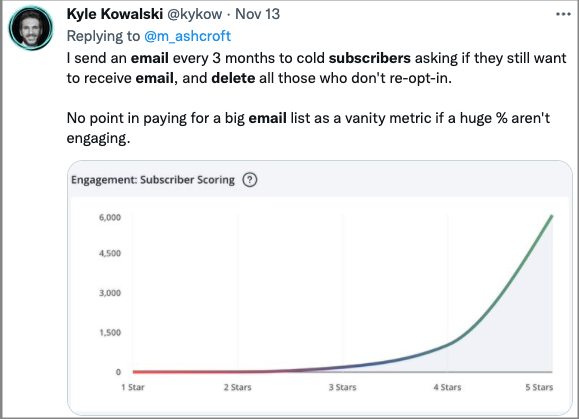Content marketers may go ‘counter-intuitive’ in 2022
As another year came to a close, I saw the usual surge in “10 trends to watch out for in 2022” articles. And yes, this is sort of one of those articles, I suppose…
This article though — it’s more about the predicted changes in the behaviours of content marketing practitioners regarding what they will do less of (and not more of), next year.
Because, whilst the industry at large continues with its somewhat head-in-the-sand, it’s-business-as-usual attitude towards content marketing, I sense the pockets of people that have long since started to question and battle against certain conventions and approaches—in their heads and hearts.
I admit — it’s somewhat refreshing to see. Digital should never stand still, right?
So let’s get on with examining a few of the counter-intuitive behaviours that a significant proportion of content marketers might shift towards in 2022.
1. Scaling down the use of gated content
No one was more surprised than me to be writing this piece about the possible decline of gated content as a content marketing tactic. I can’t remember how many conversations I’ve had with people in the past about the rationale and supposed sense behind putting a form in front of a content asset.
But something has been evolving and changing shape. And that something is buyer behaviours. Because, when 95% of buyers are simply not in the market for what you’re selling, what then is the point of collecting names and contact details via a landing page form?
People are tired of forms. People are fed up with parting with contact details and telling organisations how many people work at their company.
🔍 Related: Has gated content lost its magic?
The over-use of gated content as a tactic (for what can often seem like some kind of twisted content asset lottery) is rife. Not to mention the landing pages themselves; most of which are built in such a terrible, terrible way for the unsuspecting user — it’s almost sadistic.
Trust in how organisations treat data security and data privacy is at an all-time low.
Marketing people are also buyers, users, and customers. Some are now finding themselves advocating more and more for the ‘non-gated content’ approach.
(Screenshot taken by author)
Why? Because there has to be some faith in the real crux of inbound methodology: let’s really test the theory of your content being so consistently brilliant and engaging, that you simply don’t need an army of sales representatives to cold call or robotically email people using submitted form data.
The excellent content you’re providing will do the work. People will make the decision to proactively approach your brand when they’re ready.
All we have to do as marketers is just get over ‘the fear’ of giving that content away for free.
2. Cleaning up subscriber and contact lists (and I mean *seriously* cleaning them up)
From a ‘best practice’ and ethical standpoint, we already know what the right approach to maintaining our contact/subscriber lists is.
Yet, it somehow feels far easier to put doing things properly off completely for the majority of content marketers — or to just do a very minimal tidy up of contact entries and the deleting of ‘unsubscribed’ names every so often.
Naturally, none of us are too crazy about the idea of losing two-thirds of our database at the click of a button.
Instead, it’s far easier to silently defer this important housekeeping activity to a later date — a date when we’ll feel more comfortable, yeah?
Sadly, that day doesn’t usually arrive.
But, what I’ve noticed in 2021, is that there’s willingness to give this type of data a really good sorting out. Marketers are more prepared to face this uncomfortable task head-on.
(Screenshot taken by author)
(Screenshot taken by author)
As well as the fact that 2021 shone more light on ethical marketing practices anyway, content marketers have now realised that not investing proper time in this task can lead to poor deliverability and poor performance, over time.
Encouragingly, some are being proactive at implementing additional measures in order to keep their data in good shape — and with seemingly positive results.
(Screenshot taken by author)
3. Letting go of ‘writing for SEO’
This one’s been gaining momentum for a while. Maybe this year will mark a real sea change in attitudes regarding how people approach writing for the web (i.e to rank highly on Google).
A shift towards ‘writing for humans’ over ‘writing for SEO’ coming – and in a big way.
More proper keyword research. Less ‘keyword stuffing’.
(Screenshot taken by author)
(Screenshot taken by author)
And as we already know, Google is a clever beast. We know it sees through ‘keyword stuffing’, the precalculated pepperings of words and phrases in headings, and other such practices. So, we may as well just try writing good, informative, helpful, high quality, valuable content, right?
That’s not to say that we shouldn’t still present our content in a mindful, ‘search engine friendly’ way when we come to publishing it, but ‘hacking your content’ for SEO won’t be a factor anymore amongst the best content marketers, IMHO.
🔍 Related: SEO misconceptions that drive copywriters mad
And let’s not forget the bigger picture here. The global pandemic has triggered a more serious onus on organisations to publish accurate, high-quality content for their audiences. 2022 will therefore be less about meeting internal content marketing KPIs and goals, and more about doing what’s right for prospects and customers.
=====
(Originally written for the Content Therapy column, Better Marketing)






